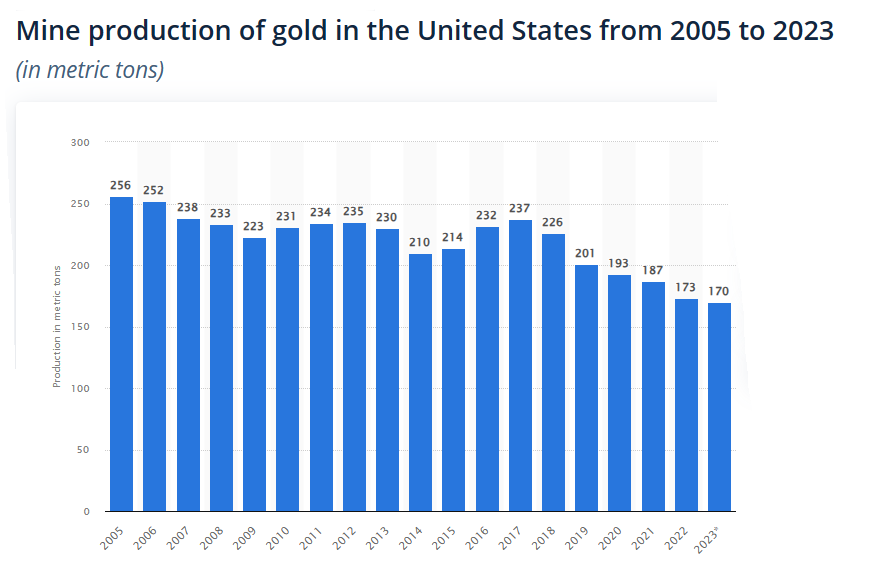
Gold: $27,533
I continually remind gold investors, whether in bullion or mining shares, not to get too euphoric when gold rallies and not to get too depressed when the dollar price retreats. Gold is still the best form of money and proves valuable to investors over time. This is true whether inflation or deflation prevails.
The key for investors is to stay focused on the long-term attributes of gold and not get caught-up in day-to-day price moves. The dollar price of gold is volatile. There’s no reason why your investment outlook needs to be volatile too.
That said, it’s worth looking at the long-term prospects for the dollar price of gold. If we’re not going to sweat the short-run, we should care about the long-run.
My Updated Gold Forecast
I have updated my forecast that gold will move past $25,000 per ounce by 2026 or sooner. That’s not a guess; it’s the result of rigorous analysis. There’s never a guarantee that a particular outcome will prevail, but this gold price forecast is based on the best available tools and models that have proved accurate in many other contexts.
By the way, this updated forecast has nothing to do with the recent gold performance. It has to do with the money supply. The quantity of official gold has been constant since 1980. All we're really saying is that if money supply goes up and the quantity of gold is fixed, then you need a higher implied price of gold to support the money supply at a 40% level. The higher market price of gold closes the gap a little but not by much. The truth is that the money supply is running away from the price of gold, so the gap is getting wider.
This is a good time to review two distinct models to explain exactly how I reach that price level forecast.
The Monetary Model
This model analysis begins with a simple question: What is the implied non-deflationary price of gold under a new gold standard? It’s a simple question with a somewhat complicated answer and a tangled history.
No central banker in the world wants a gold standard. Why would they? Right now, they control the machinery of central bank command currencies (also called fiat money). They have no interest in a form of money they can’t control. It took about 60 years from 1914 to 1974 to drive gold out of the monetary system. No central banker wants to let it back in.
Still, what if they have no choice? What if confidence in command currencies collapses due to some combination of excessive money creation, competition from Bitcoin, extreme levels of dollar debt, a new financial crisis, war or natural disaster?
In that case, central bankers may return to gold not because they want to, but because they must in order to restore order to the global monetary system.
That scenario begs the question: What is the new dollar price of gold in a system in which dollars are freely exchangeable for gold at a fixed price?
If the dollar price is too high, investors will sell gold for dollars and spend freely. Central banks will have to increase the money supply to maintain equilibrium. That’s an inflationary result.
If the dollar price is too low, investors will line up to redeem dollars for gold and then hoard the gold. Central banks will have to reduce the money supply to maintain equilibrium. That reduces velocity and is deflationary.
Something like the latter case happened in the UK in 1925 when the Exchequer returned to a gold standard at an unrealistically low price. The result was that the UK entered the Great Depression several years ahead of other developed economies.
Something like the former case happened in the U.S. in 1933, when FDR devalued the dollar against gold. Citizens were not allowed to own gold, so there was no mass redemption of gold. But other commodity prices rose sharply.
That was the point of the devaluation. Resulting inflation helped lift the U.S. out of deflation and gave the economy a boost from 1933 – 1936 in the midst of the Great Depression. (The Fed caused another severe recession in 1937 – 1938 with their customary incompetence).
The policy goal obviously is to get the price “just right” and then maintain it with open market operations using gold and dollars. The U.S. is in an ideal position to do this by selling gold from U.S. Treasury reserves, about 8,100 metric tonnes, or buying gold in the open market using freshly printed Fed money. The goal would be to maintain the dollar price of gold in a narrow range around the fixed price.
What price is just right? This question is easy to answer, subject to a few assumptions.
U.S. M1 money supply is $17.9 trillion. (I use M1, which is a good proxy for everyday money).
What is M1? This is the supply that is the most liquid and money that is the easiest to turn into cash. It contains actual cash (bills and coins), bank reserves (what is actually kept in the vaults), and demand deposits (money in your checking account that can be turned into cash easily).
The total amount of official gold the U.S. has is 8,133 metric tonnes. That equals 261.5 million troy ounces.
One needs to make an assumption about the percentage of gold backing for the money supply needed to maintain confidence. I assume 40% coverage with gold. (This was the legal requirement for the Fed from 1913 to 1946. Later it was 25%, then zero today).
Applying the 40% ratio to the $17.9 trillion money supply means that $7.2 trillion of gold is required.
Applying the $7.2 trillion valuation to 261.5 million troy ounces yields a price of $27,533 per Troy ounce of gold. That’s the implied non-deflationary equilibrium price of gold in a new global gold standard.
Of course, money supplies fluctuate; lately they’ve been going up sharply, especially in the U.S. Other measures of money such as M0 or M2 would yield different results. Exchange rate fluctuations can change dollar equivalents for foreign money supply.
There’s room for debate about whether a 40% backing ratio is too high or too low. Still, our assumptions are moderate based on monetary economics and history. A dollar price of gold of over $25,000 per ounce in a new gold standard is not a stretch. Obviously, you get around $12,500 per ounce if you assume 20% coverage.
The Fundamental Model
This model is also straightforward. It relies on factors we learned about in our first week of Intro to Economics – supply and demand.
The most significant development on the supply side is the decrease of new mining output. As the chart shows below, mine production of gold in the U.S. has been decreasing steadily since 2017.

These figures reveal a 28% decrease over 7 years, at the same time gold prices were rising and miners were motivated to expand output.
This is not to argue that the world has reached “peak gold,” (output could expand in future for a variety of reasons). Still, my contacts in the mining community consistently report that gold is becoming more difficult to source and the quality of newly discovered ore is low-to-medium at best. Flat output, all things equal, tends to put a floor under prices and to support higher prices based on other factors.
The demand side is driven largely by central banks, ETFs, hedge funds and individual purchases. Traditional institutional investors are not large investors in gold. Much of the demand from hedge funds is conducted in derivatives such as gold futures contracts and over-the-counter forwards and options. Derivatives generally do not involve physical delivery of gold but expanding open interest and buying pressure do tend to support the price.
Central bank demand for gold has surged from less than 100 metric tonnes in 2010 to 1,100 metric tonnes in 2022, a 1,000% increase in 12 years. Central bank gold demand remained strong in 2023 with 800 metric tonnes acquired through September 30, 2023. That puts central bank gold demand on track for a new record in 2023. There’s no sign of that demand slowing in 2024.
Overall, the picture is one of flat supply and increasing demand, mostly in the form of official purchases by central banks. It’s difficult to make price forecasts from supply and demand data alone without taking into account certain catalysts such as declining note yields, or a growing inflation narrative; actual inflation is another matter.
On balance, growing demand and flat supply tend to cause price increases. These price increases are consistent with the price gains derived from the monetary model described above.
A Math Lesson
Finally, a bit of elementary math is helpful in understanding how the dollar price of gold can move past $25,000 per ounce in the next two years. For this purpose, we’ll assume a baseline price of $2,000 per ounce (although gold has been in the $2,300 range lately with no signs of falling back to the $2,000 level). But for our purposes, we’ll keep it simple.
A move from $2,000 per ounce to $3,000 per ounce is a heavy lift. That’s a 50% increase and could easily take a year or more. Beyond that, a further increase from $3,000 per ounce to $4,000 per ounce is a 33% increase: another large rally. A further gain from $4,000 per ounce to $5,000 per ounce is a further gain of 25%.
But notice the pattern. Each gain is $1,000 per ounce, but the percentage increase drops from 50% to 33% to 25%. That’s because the starting point is higher while the $1,000 gain is constant. Each $1,000 jump represents a smaller (and easier) percentage gain than the one before.
This pattern continues. Moving from $9,000 per ounce to $10,000 per ounce is only an 11% gain. Moving from $14,000 per ounce to $15,000 per ounce is only a 7% gain. Gold can move 1% in a single trading day, sometimes 2% or more.
At progressively higher prices, we see the same $1,000 gain (it’s real money to you), but the percentage increase is smaller, and the hurdle is therefore lower. As an extreme example, a move from $99,000 per ounce to $100,000 per ounce is about a 1% move. All in a day’s work. Those $1,000 per ounce pops get even easier as we approach our calculated price of $27, 533.
Got Gold?
One intriguing aspect of this analysis is that the monetary model and the fundamental model produce strikingly similar results, although the models rely on different factors and different dynamics. This does not prove either forecast is correct, but it adds to the probability that they are both correct. Basic supply and demand also support the forecast of higher prices, albeit with less specificity.
The lesson for you as an investor is to buy gold now. (I recommend getting your physical gold from our friends at Hard Assets Alliance. They are helpful with any questions about purchasing gold you may have, and the process is simple).
As prices continue to rally, you’ll get more gold for your money at the outset and high percentage returns as gold rallies from a lower base. Toward the end of the long march past $25,000 per ounce, you’ll have bigger dollar gains because you started with more gold. Others will jump on the bandwagon, but you’ll already have a comfortable seat.
Want More Jim Rickards' Strategic Intelligence?
Do you like this content? Would you like to know more? Because we have this and much more to share with you. Get started today!









